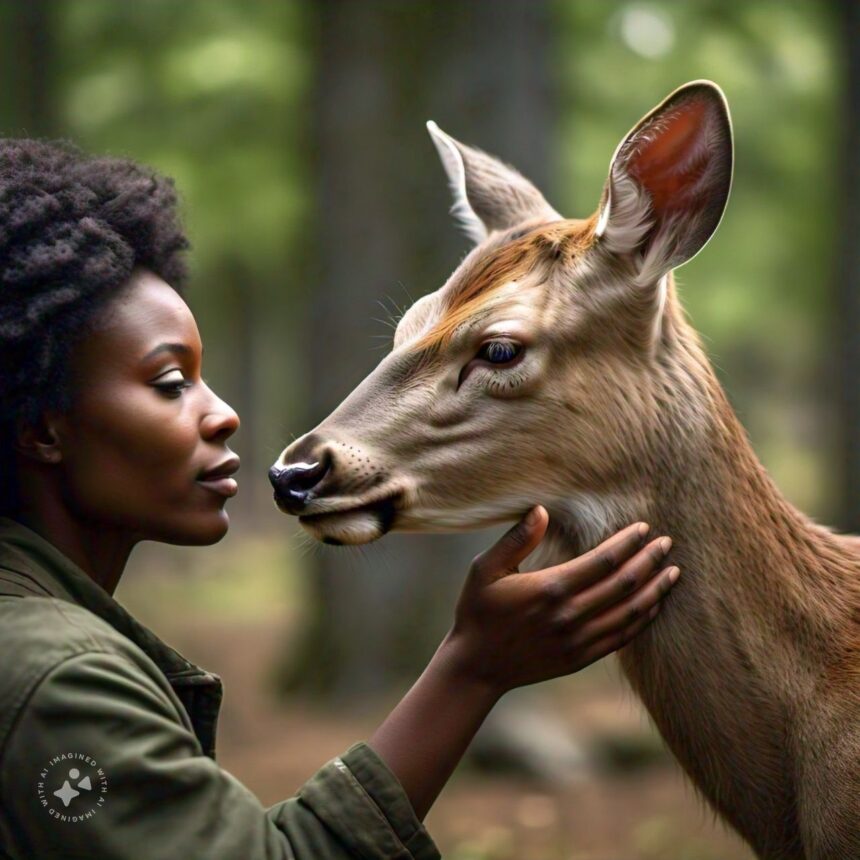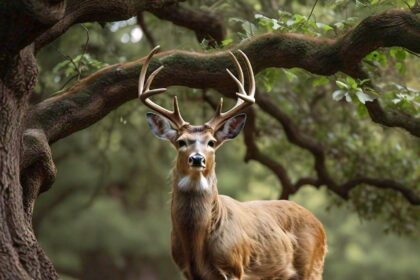In rural Missouri, a rescued deer was found labeled as a “PET,” showing the issue of keeping deer as pets. Pet deer may look cute (e.g., fallow deer), especially as fawns (baby deer), but they are wild.
They have complex needs and behaviors that make them hard and often wrong to keep as pets. This article will look at the good and bad sides of keeping deer as pets. We’ll cover legal rules, care needs, behavior, and ethical issues.
Domesticating deer is often illegal or requires special permits and care, experts say. The global trade in wildlife, including exotic pets, is worth between $30.6-42.8 billion a year. About $22.8 billion of this is legal. But, sadly, only 20% of exotic pets survive their first year, which harms wild populations.
Understanding The Challenges Of Deer Domestication
Deer are wild animals that haven’t been domesticated like dogs, goats, sheep or cats. This means they come with unique challenges for those thinking about having them as pets. They have strong instincts and behaviors from their wild life, making it hard to meet their needs in a home.
Deer As Wild Animals: Instincts And Behaviors
Deer love to move and explore, needing big, safe areas to live. Their diet is hard to match outside the wild, since they don’t eat their food over and over like some other animals do.
Deer are naturally scared of humans, which helps them stay safe in the wild. Getting deer to trust humans takes a lot of work. Mother deer might leave their babies if they feel scared, making breeding them in captivity even harder.
Legal Regulations And Permits Required
In some states to adopt deer as pets is heavily regulated, with many states needing special permits. For example, in Wisconsin, you can only keep white-tailed deer with a permit. Texas allows for “deer breeder” permits, letting people care for deer in a special way like putting up a farm.
If you don’t follow the laws for keeping deer, you could face big fines. Deer also need special veterinary care because they can get sick easily when they’re stressed or living in a small space.
In summary, raising deer as pets is a big task. They can be destructive because of their antlers and strong natural instincts, need special care, and have strict laws. It’s important to really understand these things before deciding to have a deer as an exotic pet.
Keeping Deer As Pets: Tips To Know
Housing And Dietary Requirements
Adopting deer as a pet means you need special housing and a balanced diet. Deer are not like regular pets and have different needs. You must create a large, safe area that feels like their natural home. This space should have enough room for them to move, eat, and act naturally.
Deer eat plants like grasses, leaves, and twigs. It’s important to feed them the right foods because their stomachs can’t handle many pet foods. You should give them high-quality hay, fresh veggies, and special deer food to keep them healthy.
Potential Health Concerns And Zoonotic Diseases
Deer pets can make you sick with diseases that spread from animals to people. These diseases include Brucellosis, Salmonella, and Tuberculosis. It’s important to take your deer to a veterinary medical professional often and use protective gear when you touch them to stay safe.
Deer can also be mean, especially when they’re looking for a mate. This can be dangerous, especially around kids or other people in the house. You need to train and socialize them well to keep everyone safe. But, having a wild animal as a pet is always a big risk.
In conclusion, taking care of deer pets is hard work. They need special homes, food, and health care. The risks of getting sick from them and their unpredictable nature make them bad pets for most people. Think carefully before deciding to have a deer as a pet.
Ethical Considerations Of Keeping Deer As Pets
Keeping deer as pets brings up big ethical questions. Deer are wild animals with needs that can’t be met in a home. This can cause stress, frustration, and health problems for them. The ethics of keeping deer as pets go beyond just their well-being.
The effect of the deer pet trade on wild deer is a big ethical worry. Some deer taken as pets come from their natural homes, hurting their populations. This can harm the ecosystem and the health of deer species.
- In Texas, it is not legal to own deer as pets, and Ohio also prohibits the ownership of deer as pets.
- Florida allows individuals to own deer as pets, but only with a permit, and the legal requirements can be quite stringent.
- If caught keeping a deer as a pet without the necessary permits, individuals could face fines, confiscation of the deer, and potentially criminal charges.
The welfare of the deer and their wild populations must be thoughtfully considered when thinking about keeping them as pets. The complex needs of these animals and the potential harm to their species make it hard to justify it ethically.
The captive hunting industry, which can involve the killing of endangered species, is another ethical concern. This practice, driven by overbreeding and the desire for quick kills, raises big questions about how these animals are treated.
In conclusion, the ethical issues with keeping deer as pets are complex. While some might find it appealing, the welfare of the animal and the effect on wild populations must come first. Responsible pet ownership and a focus on animal welfare should guide decisions about exotic pets like deer.
Deer Behavior And Socialization: Challenges And Risks
Thinking about keeping deer as pets means understanding their unique behavior and social ways. These animals are wild and act differently from pets. It’s key to know this to keep both the deer and their owners safe.
Aggression And Unpredictability
Deer can get more aggressive and hard to predict as they grow. Bucks, especially, might charge, kick, or attack people during mating season. This makes deer risky to be around, and owners need to be ready for these behaviors.
Habituation And Releasing Deer Into The Wild
Keeping deer as pets also brings up the problem of habituation. Deer that get used to people often can’t make it back in the wild. They lose their survival skills and face dangers like predators, struggle to find food, and lack shelter.
Understanding the behavioral and social issues with deer is crucial before getting them as pets. Owners must be ready for aggression, unpredictability, and the trouble of releasing deer back into the wild. Thinking carefully about these points is key to keeping the deer and their owners safe and happy.
Conclusion
Deer ownership is a complex task that requires a deep understanding of their needs and risks. Deer look cute but generally, wild animals may have needs that most people can’t meet. The legal rules, care needs, and ethical issues make it a bad choice for most.
Lucky enough, there are alternatives to keeping deer as pets, like supporting conservation or visiting them in the wild, is better. These options let you enjoy deer without the big responsibilities. The key considerations for deer pet ownership go beyond just wanting one. They include many areas such as thinking about the deer’s happiness, if you can take good care of it, and the risks to you, house guest and the species of deer.
In the end, deer are better off in their natural homes fending for themselves as they should. By knowing the challenges of having deer pets, people can make better choices. These choices help the animals and support taking care of our natural world.








